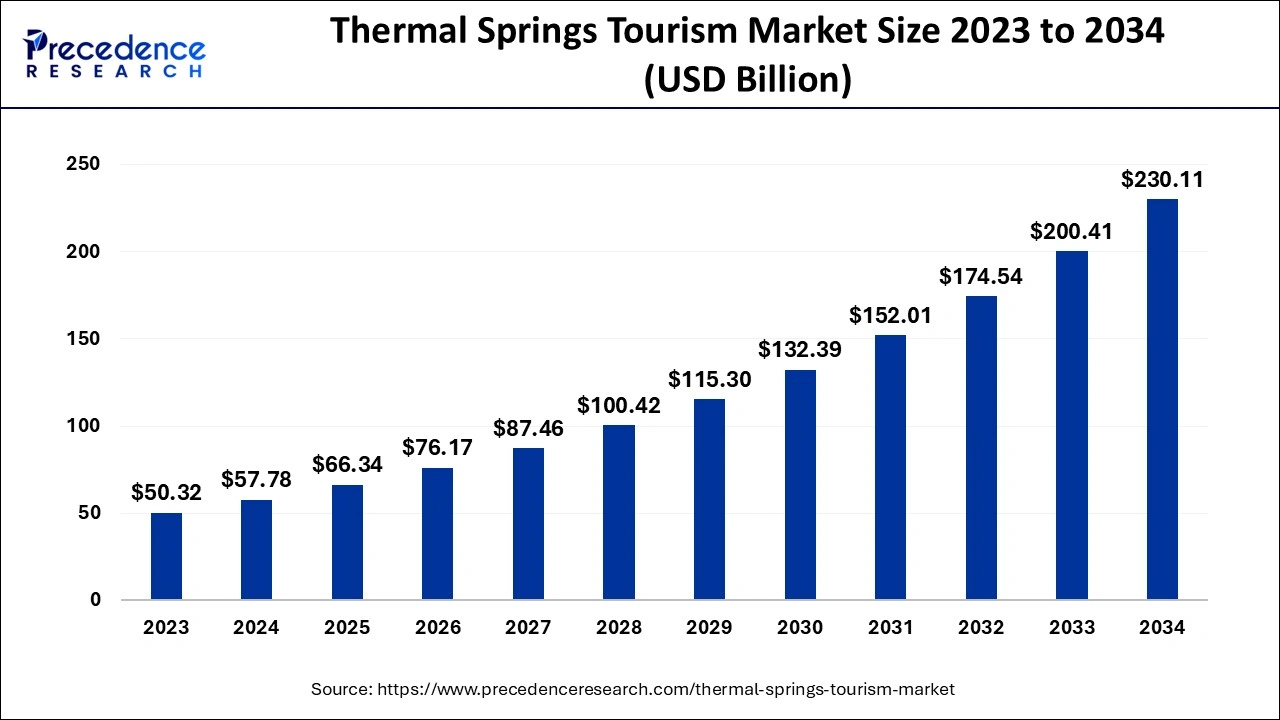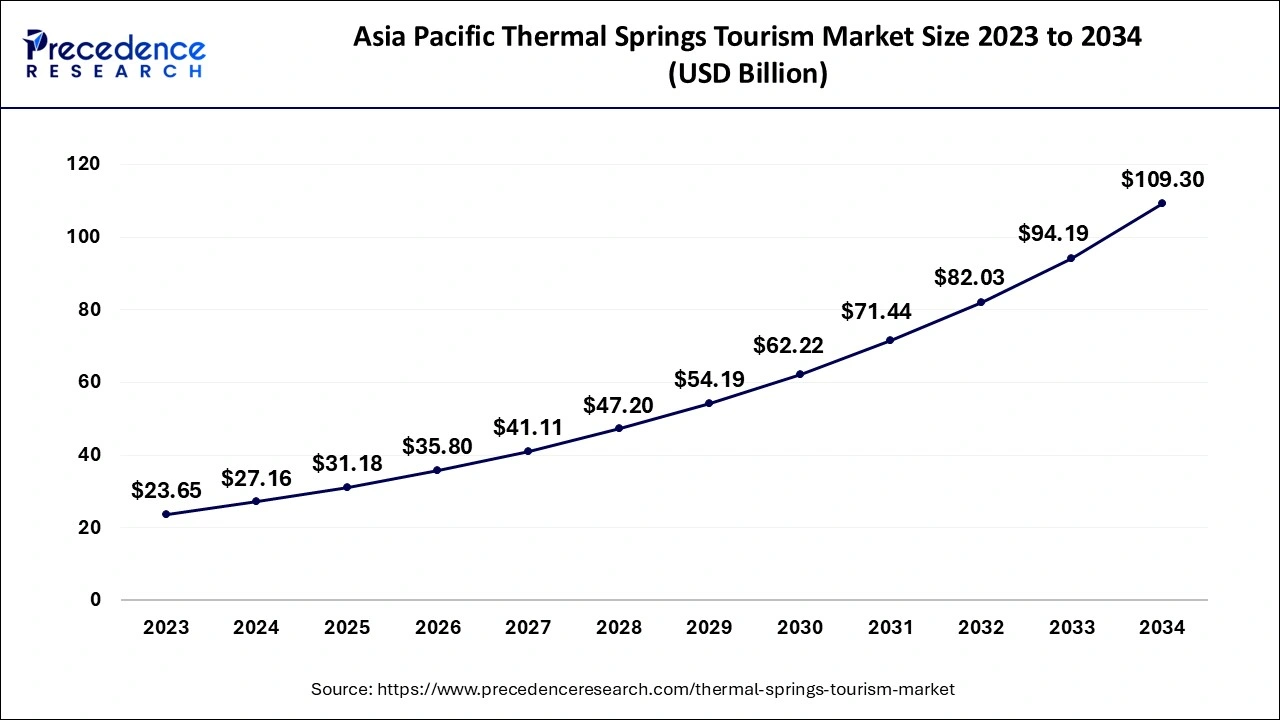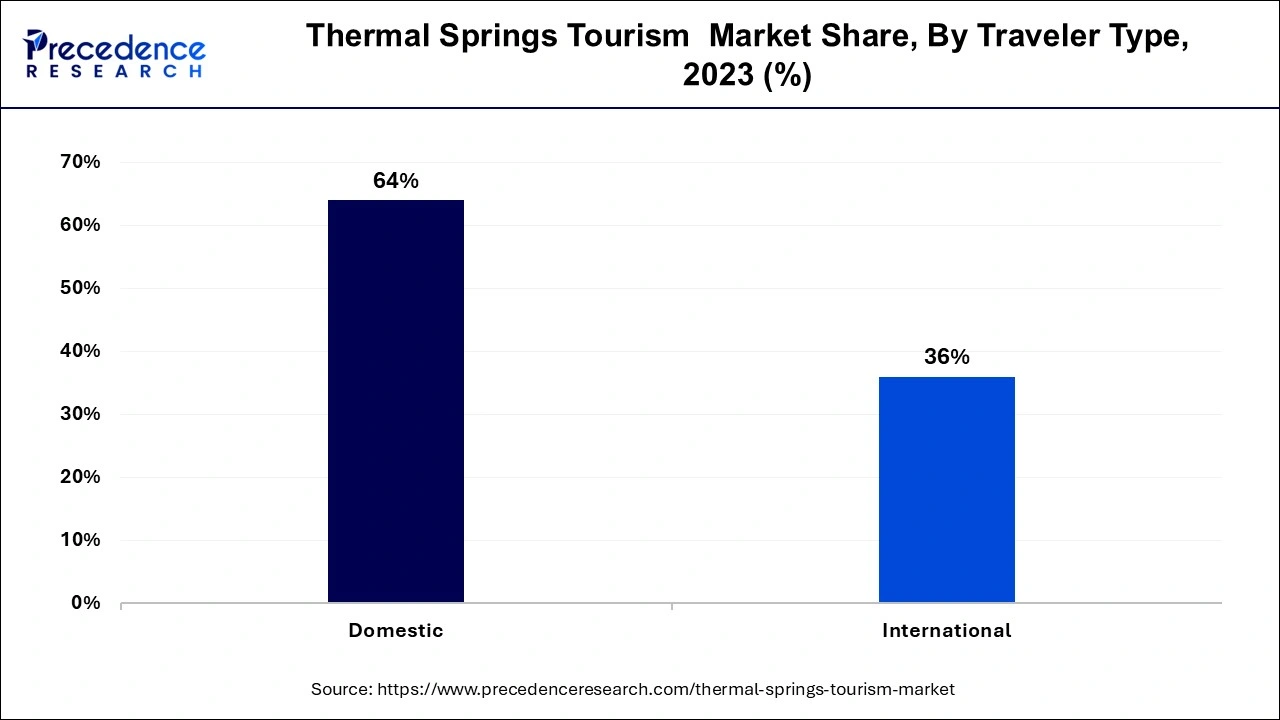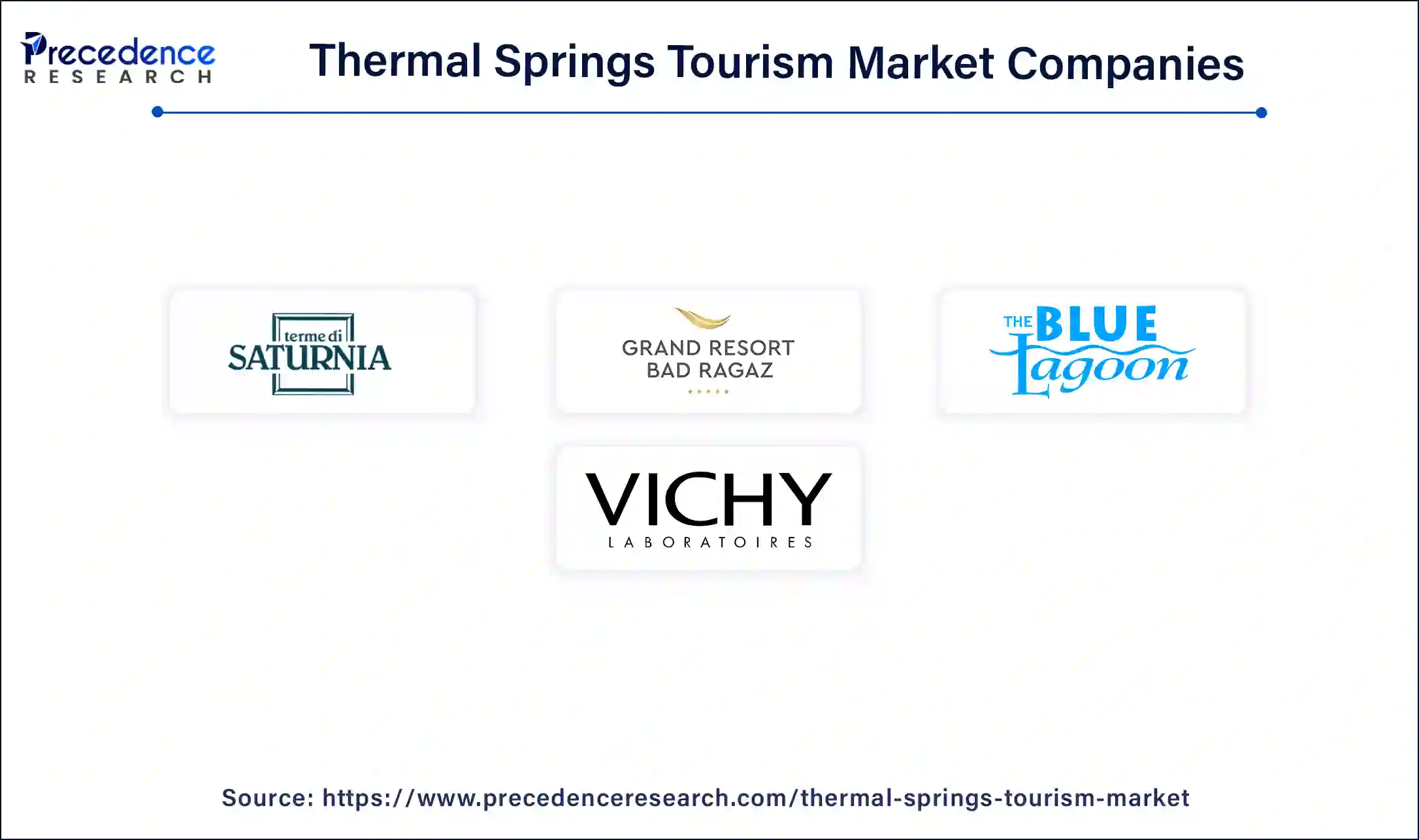July 2024
The global thermal springs tourism market size is calculated at USD 57.78 billion in 2024, grew to USD 66.34 billion in 2025 and is predicted to reach around USD 230.11 billion by 2034. The market is expanding at a CAGR of 14.82% between 2024 and 2034. The Asia Pacific thermal springs tourism market size is evaluated at USD 27.16 billion in 2024 and is expected to grow at a fastest CAGR of 14.93% during the forecast year.
The global thermal springs tourism market size accounted for USD 57.78 billion in 2024 and is projected to surpass around USD 230.11 billion by 2034, growing at a CAGR of 14.82% from 2024 to 2034. Rising consumer awareness of health benefits is the key factor driving the market's growth. Also, improved accessibility and infrastructure developments in many regions can fuel the thermal springs tourism market growth further.

The Asia Pacific thermal springs tourism market size is exhibited at USD 27.16 billion in 2024 and is anticipated to be worth around USD 109.30 billion by 2034, growing at a CAGR of 14.93% from 2024 to 2034.

Asia Pacific dominated the thermal springs tourism market in 2023. The dominance of the region can be attributed to the long-standing cultural importance of hot springs in nations such as Japan and China. Furthermore, the growth of infrastructure in other countries, such as the South Korean spa tourism market and China's investment in resorts, is helping the market to expand in the region. Governments across the Asia Pacific are facilitating wellness tourism to grow their infrastructure.
North America is expected to grow significantly in the thermal springs tourism market over the studied period. The growth of the region can be linked to the region's focus on sustainable travel and eco-tourism, as consumers are seeking unique experiences that optimize environmental stewardship along with health benefits. Moreover, The U.S. is experiencing high growth in the market because of the region's rising emphasis on alternative health practices and overall wellness.
Thermal springs tourism is a vacation where people travel to mineral springs or thermal springs for their wellness and health benefits. Thermal springs have healing properties that can help maintain the mental and physical well-being of the individual. It involves activities such as thermo mineral water baths, mud baths, physical therapy, psychotherapy, and other exercises. People may be compelled to visit thermal springs for different reasons like aesthetic, environmental, and social well-being.
World Tourism Rankings by Country in terms of Total Arrivals (2023)
| Rank | Country | Arrivals (million) |
| 1 | France | 100 |
| 2 | Spain | 85 |
| 3 | United States | 66 |
| 4 | Italy | 57.25 |
| 5 | Turkey | 55.16 |
| 6 | Mexico | 42.15 |
| 7 | United Kingdom | 37 |
| 8 | Germany | 37.4 |
| 9 | Greece | 32.74 |
| 10 | Austria | 30.91 |
How is AI Changing the Thermal Springs Tourism Market?
Artificial intelligence in tourism refers to the utilization of AI innovation to enhance different aspects of the thermal springs tourism market, such as travel planning, customer service, and marketing. It can process large amounts of data to offer customized recommendations, schedule daily tasks, and enhance decision-making processes. Furthermore, AI assistants can help customers book a hotel of their choice and add dates to their calendars.
| Report Coverage | Details |
| Market Size by 2034 | USD 230.11 Billion |
| Market Size in 2024 | USD 57.78 Billion |
| Market Size in 2025 | USD 66.34 Billion |
| Market Growth Rate from 2024 to 2034 | CAGR of 14.82% |
| Largest Market | Asia Pacific |
| Base Year | 2023 |
| Forecast Period | 2024 to 2034 |
| Segments Covered | Service Type, Traveler Type, and Regions |
| Regions Covered | North America, Europe, Asia-Pacific, Latin America and Middle East, & Africa |
Rise in interest in water-based experiences
Consumers in the thermal springs tourism market are more interested in witnessing cultural traditions, connecting with nature, and using saunas and cold plunges. These experiences also have health benefits that can support and conserve the environment and biodiversity. Additionally, Water-based experiences can help enhance the quality of life for local communities and tourists. These experiences are appealing to various groups, including friends, families, and young people. Some of the popular water-based activities are Jet skiing, Hydroflighting, Kayaking, and Surfing.
Challenges regarding customer satisfaction
Customer satisfaction is an important factor in the competitiveness of the thermal springs tourism market. Some factors that can affect customer satisfaction are service quality, convenience, environment quality, and special resources. Moreover, this business needs individuals with an extensive range of skills, such as food and beverage service and basic bath and guest room services. All these services offered require proper employee training, which can be challenging sometimes.
The expansion of the sauna and spa facilities
Tourists and travelers are increasingly seeking wellness and relaxation experiences because they find these amenities more appealing, leading to opportunities in the thermal springs tourism market. The growth in international travel has optimized the global tourism industry, leading to an increase in customer demand for this facility. Furthermore, many resorts, hotels, and other hospitality infrastructures are incorporating sauna and spa facilities into their providing as a plan to drain and retain a pool of customers.
The recreational services segment dominated the global thermal springs tourism market in 2023. The dominance of the segment can be attributed to the rising demand for these services due to a convergence of factors such as increased consumer emphasis on health and wellness. In addition, thermal spring venues also provide numerous therapeutic benefits, including enhanced physical health and relief from stress. As consumers seek out enriching and unique experiences, thermal springs have emerged as an attractive option, offering various recreational activities to visitors.
The luxury & spa services segment is expected to grow at the fastest rate in the thermal springs tourism market over the forecast period. The growth of the segment can be credited to the strong shift in customers' preferences toward wellness and holistic health, facilitating visitors to seek out high-quality spa services that improve their mental and physical health. Moreover, the emergence of wellness tourism, along with the increasing awareness of the advantages related to thermal mineral waters, is making a positive impact on segment growth.
The domestic segment led the global thermal springs tourism market. The dominance of the segment can be linked to the rising importance of health-oriented getaways and accessibility. Also, consumers are spending more time on leisure activities and seeking unique experiences. Governments can fuel domestic tourism through plans, policies, and marketing efforts, driving the flow towards more localized traveling destinations.

The international segment is anticipated to show the fastest growth in the thermal springs tourism market during the projected period. The growth of the segment can be driven by an increasing number of consumers who want to connect with nature, witness cultural traditions, and experience alternative curing methods. Furthermore, governments in many countries with well-established thermal bathing traditions are investing heavily in the sector to optimize it as a wellness tourism providing, this involves upgrading service standards and reopening facilities.

Segments Covered in the Report
By Service Type
By Traveler Type
By Geography
For inquiries regarding discounts, bulk purchases, or customization requests, please contact us at sales@precedenceresearch.com
No cookie-cutter, only authentic analysis – take the 1st step to become a Precedence Research client
July 2024